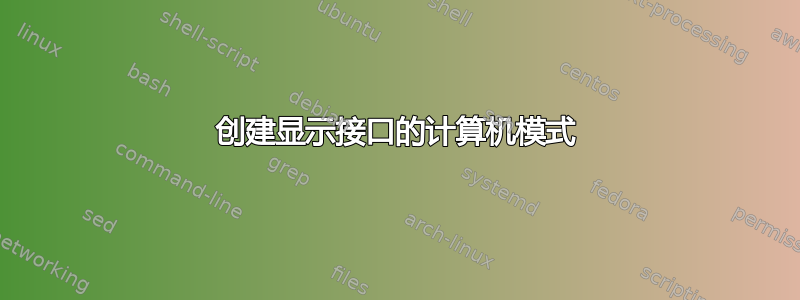
答案1
这是一个可能的解决方案:
编辑:微调边界框。
\documentclass[tikz,border=10pt]{standalone}
\usetikzlibrary{positioning, arrows, chains, shapes}
\begin{document}
\begin{tikzpicture}[auto,
>=stealth', node distance = 1.2cm and 1cm,
every node/.style={minimum height=1.5em, minimum width=8ex},
a/.style={draw, thick, anchor=center},
b/.style={a, regular polygon,regular polygon sides=4, rounded corners},
c/.style={b,circle},
start chain=0 going right, ch0/.style={on chain=0, join},
start chain=1 going right, ch1/.style={on chain=1, join},
start chain=2 going right, ch2/.style={on chain=2, join},
start chain=3 going right, ch3/.style={on chain=3, join},
arrow/.style={<->, thick,shorten >=1pt},
every join/.style={arrow},
shiftn/.style={xshift={.5\pgflinewidth},yshift=-{.5\pgflinewidth}},
shifts/.style={xshift=-{.5\pgflinewidth},yshift={.5\pgflinewidth}},
s/.style={xshift=4pt,yshift=-4pt},
]
\node[a] (eth0) {eth0};
\node[b, right=2cm of eth0] (iptables) {iptables};
\node[a, above right=2.4cm and 3cm of iptables.center, ch0] (veth0) {veth0};
\node[a, below=of veth0, ch1] (veth1) {veth1};
\node[a, below=of veth1, ch2] (veth2) {veth2};
\node[a, below=of veth2, ch3] (veth3) {veth3};
\node[a, anchor=north] (eth1) at (iptables|-veth3.south) {eth1};
\coordinate (c) at (eth0.west|-veth0.north);
\node[above=1pt of c, anchor=south west] (lroot) {netns root};
\draw[arrow] (iptables) -- (veth0);
\draw[arrow] (iptables) -- (veth1);
\draw[arrow] (iptables) -- (veth2);
\draw[arrow] (iptables) -- (veth3);
\path[draw] (eth0) edge[arrow, ->] (iptables)
(iptables) edge[arrow, ->] (eth1);
\draw[thick] ([shiftn]current bounding box.north west) rectangle
([shifts]current bounding box.south east);
\node[above=of lroot.south west, anchor=south west] {Gateway};
\begin{scope}[node distance=2cm]
\node[a, right=of veth0, ch0] (main0) {main};
\node[a, right=of veth1, ch1] (main1) {main};
\node[a, right=of veth2, ch2] (main2) {main};
\node[a, right=of veth3, ch3] (main3) {main};
\end{scope}
\node[a, right=of main0, ch0] (tun0) {tun0};
\node[a, right=of main1, ch1] (tun1) {tun0};
\node[a, right=of main2, ch2] (tun2) {tun0};
\node[a, right=of main3, ch3] (tun3) {tun0};
\begin{scope}[local bounding box=bb0]
\node[above=1pt of main0.north west, anchor=south west] {netns vpn0};
\node[c, right=of tun0, ch0] (ssh0) {SSH};
\end{scope}
\begin{scope}[local bounding box=bb1]
\node[above=1pt of main1.north west, anchor=south west] {netns vpn1};
\node[c, right=of tun1, ch1] (ssh1) {SSH};
\end{scope}
\begin{scope}[local bounding box=bb2]
\node[above=1pt of main2.north west, anchor=south west] {netns vpn2};
\node[c, right=of tun2, ch2] (ssh2) {SSH};
\end{scope}
\begin{scope}[local bounding box=bb3]
\node[above=1pt of main3.north west, anchor=south west] {netns vpn3};
\node[c, right=of tun3, ch3] (ssh3) {SSH};
\end{scope}
\draw[thick] ([xshift={.25\pgflinewidth},yshift=-{.5\pgflinewidth}]bb0.north west)
rectangle ([s]bb0.south east);
\draw[thick] ([xshift={.25\pgflinewidth},yshift=-{.5\pgflinewidth}]bb1.north west)
rectangle ([s]bb1.south east);
\draw[thick] ([xshift={.25\pgflinewidth},yshift=-{.5\pgflinewidth}]bb2.north west)
rectangle ([s]bb2.south east);
\draw[thick] ([xshift={.25\pgflinewidth},yshift=-{.5\pgflinewidth}]bb3.north west)
rectangle ([s]bb3.south east);
\draw[thick] ([shiftn]current bounding box.north west) rectangle
([xshift=.5cm, yshift={.5\pgflinewidth}]current bounding box.south east);
\node[below=8pt of eth1, font=\Large] {Client side};
\node[left=8pt of eth0, font=\Large] {Support side};
\end{tikzpicture}
\end{document}




